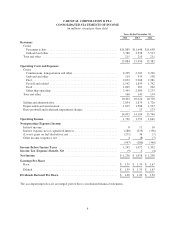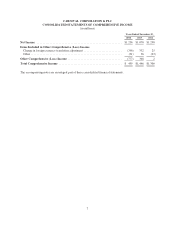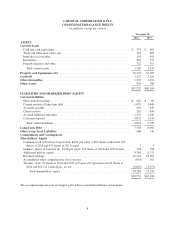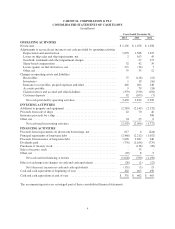Carnival Cruises 2014 Annual Report Download - page 18
Download and view the complete annual report
Please find page 18 of the 2014 Carnival Cruises annual report below. You can navigate through the pages in the report by either clicking on the pages listed below, or by using the keyword search tool below to find specific information within the annual report.NOTE 3 – DLC Arrangement
In 2003, Carnival Corporation and Carnival plc completed a DLC transaction, which implemented Carnival
Corporation and Carnival plc’s DLC arrangement. The contracts governing the DLC arrangement provide that
Carnival Corporation and Carnival plc each continue to have separate boards of directors, but the boards and
senior executive management of both companies are identical. The constitutional documents of each of the
companies also provide that, on most matters, the holders of the common equity of both companies effectively
vote as a single body. On specified matters where the interests of Carnival Corporation’s shareholders may differ
from the interests of Carnival plc’s shareholders (a “class rights action” such as transactions primarily designed
to amend or unwind the DLC arrangement), each shareholder body will vote separately as a class. Generally, no
class rights action will be implemented unless approved by both shareholder bodies.
Upon the closing of the DLC transaction, Carnival Corporation and Carnival plc also executed the Equalization
and Governance Agreement, which provides for the equalization of dividends and liquidation distributions based
on an equalization ratio and contains provisions relating to the governance of the DLC arrangement. Because the
equalization ratio is 1 to 1, one Carnival plc ordinary share is entitled to the same distributions, subject to the
terms of the Equalization and Governance Agreement, as one share of Carnival Corporation common stock. In a
liquidation of either company or both companies, if the hypothetical potential per share liquidation distributions
to each company’s shareholders are not equivalent, taking into account the relative value of the two companies’
assets and the indebtedness of each company, to the extent that one company has greater net assets so that any
liquidation distribution to its shareholders would not be equivalent on a per share basis, the company with the
ability to make a higher net distribution is required to make a payment to the other company to equalize the
possible net distribution to shareholders, subject to certain exceptions.
At the closing of the DLC transaction, Carnival Corporation and Carnival plc also executed deeds of guarantee.
Under the terms of Carnival Corporation’s deed of guarantee, Carnival Corporation has agreed to guarantee all
indebtedness and certain other monetary obligations of Carnival plc that are incurred under agreements entered
into on or after the closing date of the DLC transaction. The terms of Carnival plc’s deed of guarantee mirror
those of Carnival Corporation’s. In addition, Carnival Corporation and Carnival plc have each extended their
respective deeds of guarantee to the other’s pre-DLC indebtedness and certain other monetary obligations, or
alternatively have provided standalone guarantees in lieu of utilization of these deeds of guarantee, thus
effectively cross guaranteeing all Carnival Corporation and Carnival plc indebtedness and certain other monetary
obligations. Each deed of guarantee provides that the creditors to whom the obligations are owed are intended
third-party beneficiaries of such deed of guarantee.
The deeds of guarantee are governed and construed in accordance with the laws of the Isle of Man. Subject to the
terms of the deeds of guarantee, the holders of indebtedness and other obligations that are subject to the deeds of
guarantee will have recourse to both Carnival plc and Carnival Corporation, though a Carnival plc creditor must
first make written demand on Carnival plc and a Carnival Corporation creditor on Carnival Corporation. Once
the written demand is made by letter or other form of notice, the holders of indebtedness or other obligations may
immediately commence an action against the relevant guarantor. Accordingly, there is no requirement under the
deeds of guarantee to obtain a judgment, take other enforcement actions or wait any period of time prior to taking
steps against the relevant guarantor. All actions or proceedings arising out of or in connection with the deeds of
guarantee must be exclusively brought in courts in England.
Under the terms of the DLC transaction documents, Carnival Corporation and Carnival plc are permitted to
transfer assets between the companies, make loans to or investments in each other and otherwise enter into
intercompany transactions. The companies have entered into some of these types of transactions and may enter
into additional transactions in the future to take advantage of the flexibility provided by the DLC arrangement,
and to operate both companies as a single unified economic enterprise in the most effective manner. In addition,
under the terms of the Equalization and Governance Agreement and the deeds of guarantee, the cash flows and
assets of one company are required to be used to pay the obligations of the other company, if necessary.
16
























